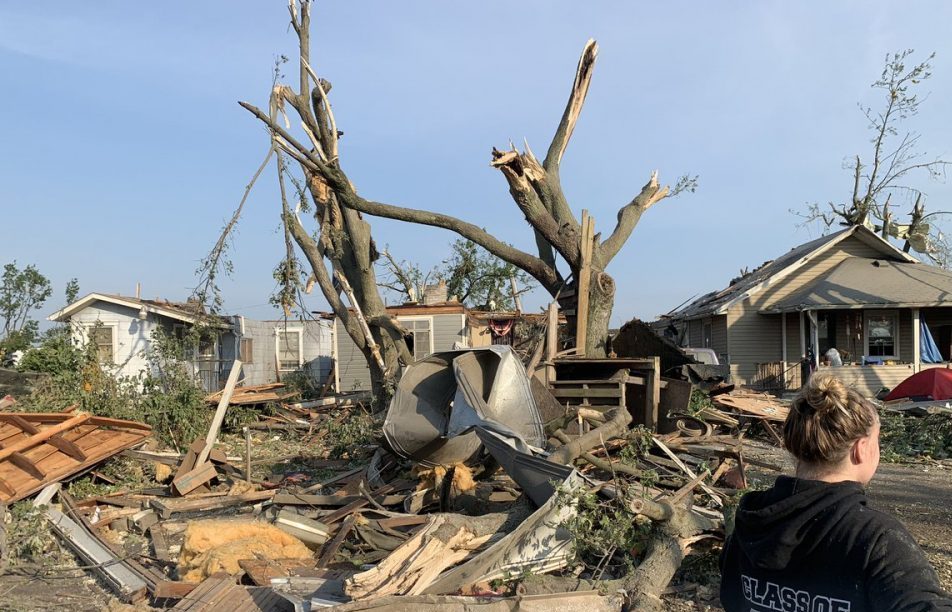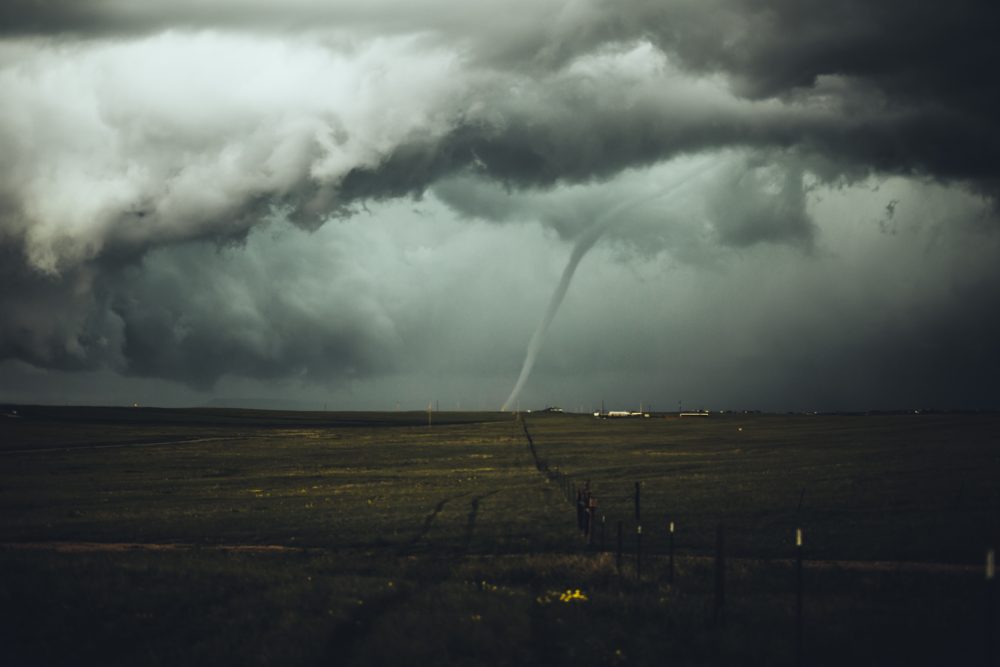
Last updated:
May Tornado Outbreak

Overview
Tornado season occurs in spring and 2019 was exceptionally active.
In May, there were 13 consecutive days with eight tornadoes or more, breaking a record set in June 1980 of 11 consecutive days. And in those 13 days, there were nearly 500 tornado reports – the most on record for the month of May – and 288 confirmed tornadoes. Fifty of these were significant events (higher than EF-2) including 18 EF-3 and two EF-4 tornadoes.
(Photo: Tornado damage in Dayton, Ohio. Source: Twitter photo/Nan Whaley, mayor of Dayton)
While many of these tornadoes were small or did minimal damage, others caused significant damage and loss of life. The swath of tornado destruction this spring – including damaged homes, downed power lines, uprooted trees, not to mention deaths and injuries – spreads across nearly one-third of the continental U.S., including Idaho, Colorado, Oklahoma, Missouri, Mississippi, Alabama, Kansas, Texas, Ohio, Arkansas, Nebraska, Indiana, New Jersey, Louisiana and Pennsylvania. There were seven deaths during this tornado outbreak; all occurred from tornadoes that hit during the night.
May 29

On Wednesday, May 29, there were 35 tornadoes from Texas to Iowa with the majority (24) being small EF-0 tornadoes. One person died in Kentucky.
May 28
On Tuesday, May 28, tornadoes hit Kansas, Missouri and New Jersey. A large wedge-shaped – half a mile to a mile wide – and rain-wrapped tornado hit just outside Kansas City, injuring 12 and damaging at least 30 homes. Rain-wrapped tornadoes are harder to spot, especially without radar. The tornado touched down outside of Lawrence as an EF-3 and also hit Pleasant Grove, Bonner Springs and Linwood. By the time it reached Linwood it was an EF-4 with peak winds of 170 mph. It is estimated that the tornado traveled more than 30 miles over the course of nearly an hour. It injured 18 people, damaged homes, destroyed power lines and downed trees. This was the first violent tornado – EF-4 or higher – in Kansas in three years and the first in the month of May. Another tornado touched down across the state line in Missouri, near Kearney in Clay County and moved toward Excelsior Springs. Neither tornado has been rated yet. A small tornado in New Jersey touched down in Sussex County, damaging a high school and leaving thousands without power.
May 27
A large cluster of 15 tornadoes hit Dayton, Ohio and Pendleton, Indiana late on Memorial Day, May 27. The tornadoes were tightly-packed and came one after another “rapid-fire” with at least one crossing the path of another. An EF-3 tornado touched down in Celina damaging several homes and leading to one death. In addition to the significant damage, at least one death and 130 injuries were reported.
Another tornado traveled through several Ohio towns, strengthening from an EF-2 in Brookville to an EF-3 in Trotwood and becoming an EF-4 in Dayton. The tornado was on the ground for several miles, damaged hundreds of houses and destroyed close to 75. At the height of the electrical outages, more than five million people were without power. The Department of Transportation used snowplows to clear debris from Interstate 75.
May 25
In Oklahoma, an EF-3 tornado tore through El Reno on May 25, destroying Skyview Estates, a mobile home community of about 88 units. The tornado traveled over two miles in four minutes before lifting. Residents only had five minutes warning before the tornado touched down. Two people were killed and 29 injured. This tornado came nearly six years after the widest tornado on record decimated parts of El Reno on May 31, 2013.
May 22
A six-county area in Missouri was hit on May 22, the 8th anniversary of the 2011 Joplin tornado, including an EF-1 in Eldon. Hardest hit (with a high-end EF-3) was Jefferson City, although unlike Joplin, there were no deaths reported immediately; one man died on May 26 as a result of injuries sustained during the tornado. Damage reports for the area stand at 82 homes destroyed, 165 with major damage and 268 with minor damage.
May 17-21
Between Friday, May 17 and Tuesday, May 21 more than 80 tornadoes blew through eight states, affecting a number of communities across Texas, Arkansas, Kansas, Nebraska, Missouri, Louisiana, Iowa and Oklahoma. All combined, over 100 homes and structures were damaged or destroyed, four people died and a number of injuries were reported.
The full extent of damage has yet to be determined. Damage assessment is ongoing. These are the kinds of activities that will require support:
- Cleaning, repairing and rebuilding of damaged homes and businesses.
- Replacement of vehicles, appliances and furniture lost in the tornadoes.
- Emotional and spiritual care, especially for families.
- Long-term recovery will include restoration of property, business recovery and environmental cleanup. Long-term mental health and trauma support will also be required.
Contact CDP
Recovery updates
If you are a responding NGO or a donor, please send updates on how you are working on recovery from this disaster to Tanya Gulliver-Garcia.
Donor recommendations
If you are a donor looking for recommendations on how to help with disaster recovery, please email Regine A. Webster.
We welcome the republication of our content. Please credit the Center for Disaster Philanthropy.
Philanthropic and government support
Thanks to support from Google and the generosity of online donors, we’ve awarded a grant to The Dayton Foundation to support medium- and long-term recovery in communities affected by this disaster.
Learn more about our partnership with Google and how we are working together to provide donors worldwide the opportunity to be responsive and effective with their disaster giving.
CDP has created a list of suggestions for foundations to consider related to disaster giving. These include:
Take the long view: Even while focusing on immediate needs, remember that it will take some time for the full range of needs to emerge. Be patient in planning for disaster funding. Recovery will take a long time, and funding will be needed throughout.
Recognize there are places private philanthropy can help that government agencies might not: Private funders have opportunities to develop innovative solutions to help prevent or mitigate future disasters that the government cannot execute.
All funders are disaster philanthropists: Even if your organization does not work in a particular geographic area or fund immediate relief efforts, you can look for ways to tie disaster funding into your existing mission. If you focus on education, health, children or vulnerable populations, disasters present prime opportunities.
Ask the experts: If you are considering supporting an organization that is positioned to work in an affected area, do some research. National Volunteer Organizations Active in Disasters has lists of organizations working in affected communities. Local community foundations also have insights into nongovernmental organizations (NGOs) that are best suited to respond in a particular community.
Resources

Tornadoes
The National Weather Service defines tornadoes as “a violently rotating column of air touching the ground, usually attached to the base of a thunderstorm.” The U.S. is home to more tornadoes than any other country in the world, with approximately 900 to 1,700 tornadoes occurring a year throughout the country.

Is your community prepared for a disaster?
Explore the Disaster Playbook